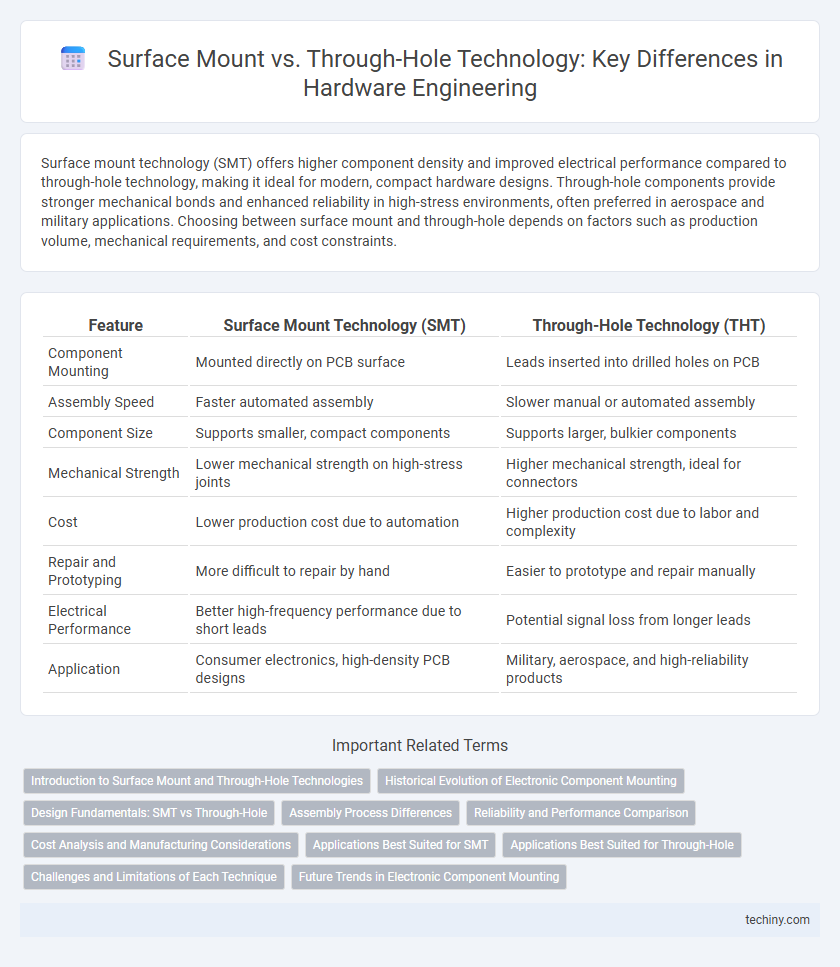Surface mount technology (SMT) offers higher component density and improved electrical performance compared to through-hole technology, making it ideal for modern, compact hardware designs. Through-hole components provide stronger mechanical bonds and enhanced reliability in high-stress environments, often preferred in aerospace and military applications. Choosing between surface mount and through-hole depends on factors such as production volume, mechanical requirements, and cost constraints.
Table of Comparison
| Feature | Surface Mount Technology (SMT) | Through-Hole Technology (THT) |
|---|---|---|
| Component Mounting | Mounted directly on PCB surface | Leads inserted into drilled holes on PCB |
| Assembly Speed | Faster automated assembly | Slower manual or automated assembly |
| Component Size | Supports smaller, compact components | Supports larger, bulkier components |
| Mechanical Strength | Lower mechanical strength on high-stress joints | Higher mechanical strength, ideal for connectors |
| Cost | Lower production cost due to automation | Higher production cost due to labor and complexity |
| Repair and Prototyping | More difficult to repair by hand | Easier to prototype and repair manually |
| Electrical Performance | Better high-frequency performance due to short leads | Potential signal loss from longer leads |
| Application | Consumer electronics, high-density PCB designs | Military, aerospace, and high-reliability products |
Introduction to Surface Mount and Through-Hole Technologies
Surface mount technology (SMT) involves directly mounting electronic components onto the surface of printed circuit boards (PCBs), enabling higher component density and improved manufacturing efficiency. Through-hole technology (THT) requires inserting component leads into drilled holes on the PCB, providing stronger mechanical connections ideal for components subjected to mechanical stress. Both SMT and THT play critical roles in hardware engineering, influencing design choices based on factors like assembly process, reliability, and application requirements.
Historical Evolution of Electronic Component Mounting
Surface mount technology (SMT) revolutionized electronic component mounting by replacing traditional through-hole techniques first developed in the 1950s, enabling higher component density and automated assembly. Through-hole mounting involved inserting leads into drilled holes on printed circuit boards (PCBs), offering robust mechanical bonds critical in the early era of electronic design. The evolution from through-hole to SMT accelerated with the advent of miniaturization and advanced manufacturing processes in the 1980s, driving modern hardware engineering towards more compact, reliable, and cost-effective devices.
Design Fundamentals: SMT vs Through-Hole
Surface Mount Technology (SMT) enables higher component density and improved electrical performance by mounting components directly onto the PCB surface, while Through-Hole Technology involves inserting component leads into drilled holes for enhanced mechanical strength. SMT supports automated assembly and cost-effective manufacturing, crucial for compact and complex circuit designs. Through-Hole offers superior durability in high-stress applications, making it ideal for connectors and heavy components requiring robust physical support.
Assembly Process Differences
Surface mount technology (SMT) involves placing components directly onto the PCB surface, enabling faster automated assembly with higher component density and smaller footprints. Through-hole technology requires inserting component leads through drilled holes, followed by soldering, which is more labor-intensive and less suited for high-speed automated processes but offers stronger mechanical bonds. SMT assembly typically uses pick-and-place machines and reflow soldering, whereas through-hole assembly often involves wave soldering or manual soldering techniques.
Reliability and Performance Comparison
Surface mount technology (SMT) offers higher component density and better high-frequency performance due to shorter lead lengths, enhancing signal integrity and reducing parasitic inductance. Through-hole components provide superior mechanical strength and reliability in high-stress environments, making them ideal for applications with significant thermal cycling or mechanical vibrations. Performance-wise, SMT excels in compact, high-speed circuits, while through-hole ensures long-term durability in rugged conditions.
Cost Analysis and Manufacturing Considerations
Surface mount technology (SMT) offers lower assembly costs due to automated placement and faster production times compared to through-hole technology, which requires more labor-intensive manual insertion. Through-hole components provide enhanced mechanical strength and reliability in high-stress environments but incur higher manufacturing costs and longer production cycles. Cost analysis favors SMT for high-volume production with space constraints, while through-hole remains preferable for prototype development and applications demanding robust physical connections.
Applications Best Suited for SMT
Surface Mount Technology (SMT) excels in applications requiring high-density circuit boards, such as smartphones, laptops, and wearables, where compact size and weight reduction are critical. SMT components are ideal for automated production lines due to their smaller size and ease of placement, enhancing manufacturing speed and efficiency in consumer electronics and automotive control systems. The technology is also favored in high-frequency circuits and RF devices because of shorter lead lengths that reduce parasitic inductance and improve performance.
Applications Best Suited for Through-Hole
Through-hole technology excels in applications requiring strong mechanical bonding, such as connectors, switches, and high-stress components in automotive and aerospace electronics. Its robust solder joints provide superior durability and reliability under thermal cycling and mechanical stress compared to surface mount devices. Through-hole mounting is preferred in prototype development and repair-friendly designs due to easier manual assembly and component replacement.
Challenges and Limitations of Each Technique
Surface mount technology (SMT) faces challenges with heat dissipation and mechanical stress due to smaller component sizes, making it less suitable for high-power or high-reliability applications. Through-hole mounting offers superior mechanical strength and reliability in harsh environments but struggles with higher manufacturing costs and limited circuit density due to larger hole drilling requirements. Both techniques present limitations in repairability and automation complexity, with through-hole assemblies often requiring manual soldering and SMT demanding precise placement and reflow processes.
Future Trends in Electronic Component Mounting
Surface mount technology (SMT) dominates future trends in electronic component mounting due to its compatibility with miniaturization, higher component density, and automated assembly processes. The ongoing development of advanced materials and 3D mounting techniques further enhances SMT's efficiency and reliability, outperforming traditional through-hole technology in speed and cost-effectiveness. Emerging applications in flexible electronics and IoT devices accelerate the transition from through-hole to surface mount components, driven by demands for lightweight, compact, and high-performance hardware solutions.
Surface Mount vs Through-Hole Infographic

 techiny.com
techiny.com